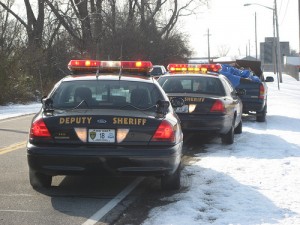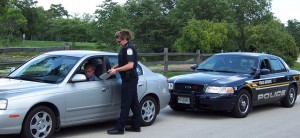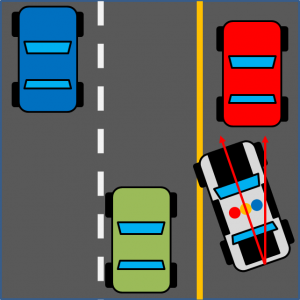I thought I should make my first real post about elegant solutions. I love them. They fit so perfectly into a problem that, in retrospect, other solutions seem ridiculous. I’d like to talk about just one example that imbues me with a sense of faith in humanity every time I see it: the traffic stop angled parking.
I found it surprisingly difficult to find a clear picture of it.
Up until the first time I saw this, I’d read reports and seen videos of police being crushed between one of the two stopped cars (the police cruiser or the car that the police officer stopped) and a passing car. Some drivers become so transfixed at the event on the side of the road that their vehicle will follow their gaze and cross the painted lines. Since the slower lanes are to the right, that tends to be where a driver pulls over. This was particularly problematic because the side most likely to be struck, the driver’s side, was the side on which the officer spent the most time during a stop. It was getting lethal just to perform routine traffic stops.
I remember all of the solutions that were laid on the table. One idea was for officers to carry a barrier (either removed from the trunk and placed or mechanically attached to and deployed from the cruiser). Some were considering compelling officers to guide a traffic stop off of main roads and into commercial parking areas. Another considered a bank of lights or noise makers. One suggestion involved making it a law that drivers approaching such a stop had to change lanes to the left, away from the traffic stop, so that the lane nearest the officer is empty (ever since, I do this whenever possible).
As far as I know, they didn’t do any of those things. Instead, they simply park at a roughly 30 degree angle, the rear of the cruiser farther to the right and front of the cruiser farther to the left.
This is an elegant solution, though it may not at first be obvious. Here’s why:
1) First and most importantly, it provides physical security to the officer. There is a no-brainer tactical principle (that is often overlooked) of putting something between you and whatever is trying to hurt you. A motor vehicle headed for the officer must first collide with the parked police cruiser.
2) There is a second psychological effect as powerful as the physical, the result of seeing the side of a car in front of the driver instead of the rear. This likely elicits a greater cautionary response than the rear of the vehicle would simply because drivers see the rear of cars just as part of driving. “Broadside” almost certainly translates to “collision,” the fear response “waking up” a driver.
3) Lastly, very importantly, it costs no more than an email with a 2-minute instructional video (really, a diagram or a text description would suffice) to put this solution into practice.
Think about that. It works on both the physical and psychological aspects and it doesn’t cost anything. That means that, without a Congressional hearing and years of debate and design and training programs, this can be implemented from New York to San Diego, London to Bangladesh, all with no more time investment than 90 seconds out of a meeting. “Hey, we’re doing it this way now. Be safe. See you tomorrow.”
It’s simple. It’s subtle. It saves lives. It’s elegant.
-CG



